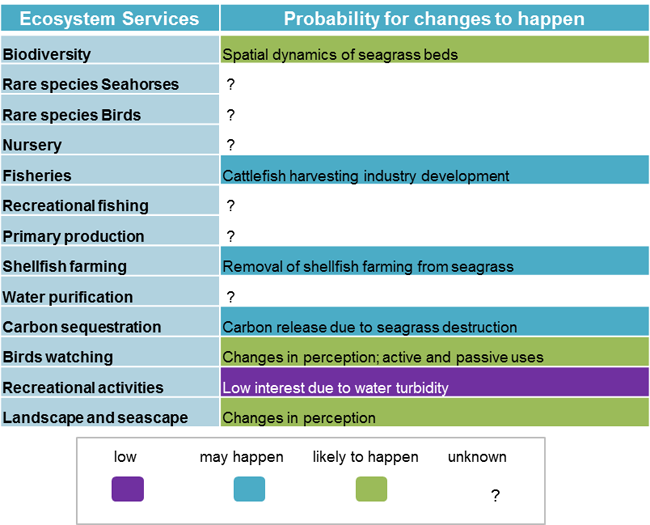2.3.2.4 Triage sequence 2.1: What is the potential for the status or value of ecological functions and services to change?

The 3 questions of this sequence 2 of the triage are run together. An example of the way it can be done is presented at the end of the sequence.
Sensitivity assessment methods are a way to implement sequence 2 of the triage process ![]() .
.
 TRIAGE SEQUENCE 2
TRIAGE SEQUENCE 2
Refinement of scope of the ecosystem services assessment in support of scenarios building and policy design
Question 4
What is the potential for the status or value of ecological functions and services to change?
The purpose of this question is to estimate whether the considered ecological functions or ecosystem services are likely to undergo significant changes in the future.
Such changes may be the result of on-going natural processes or the evolution of human pressures on the ecosystems, due to new practices, new technologies or new activities.
In a first step, the estimate of potential for change can be based on expert knowledge and consensus. Specific methodologies for assessing the sensitivity of ecosystem services to change may be implemented when needed.

Example
Example of application in the context of three French sites (VALMER project):
- In the golfe Normand-Breton study site
 , where the scope of the ecosystem services assessment purposes is broad (initial diagnosis and possible changes exploration), a list of up to 20 factors of change was drawn up. Obviously, a sound consideration of all these factors will not be feasible: as a consequence, scenarios will focus on particularly sensitive habitats, key economic factors (for instance the installation of wind-farms or changes in fishing or shellfish farming practices) or important social concerns (for instance cultural values associated with some particular habitats or services). However, the sorting of the factors of change which are of the highest interest will be the result of a dedicated stakeholder meeting.
, where the scope of the ecosystem services assessment purposes is broad (initial diagnosis and possible changes exploration), a list of up to 20 factors of change was drawn up. Obviously, a sound consideration of all these factors will not be feasible: as a consequence, scenarios will focus on particularly sensitive habitats, key economic factors (for instance the installation of wind-farms or changes in fishing or shellfish farming practices) or important social concerns (for instance cultural values associated with some particular habitats or services). However, the sorting of the factors of change which are of the highest interest will be the result of a dedicated stakeholder meeting. - In the Parc Naturel Marin d’Iroise study site
 , the intrinsic ecological dynamics of kelp habitats is not a matter of concern, but the significant factors of change are rather to be found in economic and institutional changes. The kelp processing industry is developing rapidly worldwide and also in Brittany, which drives a rising demand for kelp fishing in the Parc Naturel de la Mer d’Iroise area. This particular economic context results in projects for building new boats with increased capacities and for harvesting more kelp species. In response to this economic drivers of change, management measures are envisaged for controlling kelp harvesting while achieving balanced trade-offs between the services delivered by kelps.
, the intrinsic ecological dynamics of kelp habitats is not a matter of concern, but the significant factors of change are rather to be found in economic and institutional changes. The kelp processing industry is developing rapidly worldwide and also in Brittany, which drives a rising demand for kelp fishing in the Parc Naturel de la Mer d’Iroise area. This particular economic context results in projects for building new boats with increased capacities and for harvesting more kelp species. In response to this economic drivers of change, management measures are envisaged for controlling kelp harvesting while achieving balanced trade-offs between the services delivered by kelps.
- In the Golfe du Morbihan study site
 , a preliminary attempt to link each of the ecosystem services delivered by seagrass bed and the current factors of change was carried out. The exercise was made complicated because of the uncertainties which remain as regards the status and dynamics of many of the services which are delivered by seagrass beds in this particular area. However, based on the available knowledge at this stage of the process, it was possible to identify that the spatial dynamics of the seagrass beds on the one hand and the changes in perceptions as regards cultural services on the other hand could be considered as the main expected changes in the future
, a preliminary attempt to link each of the ecosystem services delivered by seagrass bed and the current factors of change was carried out. The exercise was made complicated because of the uncertainties which remain as regards the status and dynamics of many of the services which are delivered by seagrass beds in this particular area. However, based on the available knowledge at this stage of the process, it was possible to identify that the spatial dynamics of the seagrass beds on the one hand and the changes in perceptions as regards cultural services on the other hand could be considered as the main expected changes in the future
Table: Factors of changes affecting ecosystem services delivered by seagrass beds in the Morbihan Gulf .
.


